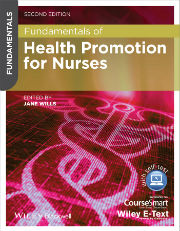
Fundamentals of Health Promotion for Nurses
Second Edition
Edited by Jane Wills

Short Answer Questions
Chapter 18: Children's nursing and health promotion
1. What are the principal health promotion priorities for children?
-
Your answer might include:
- Overweight and obesity
- Improving access to treatment
- Reducing accidental injuries
- Increasing immunizations against childhood diseases
- Safeguarding children
- Mental health promotion
2. Why is it particularly important to invest in the early years of life?
Events that occur in early life, even in utero, affect health and well-being in later life. This may be through changes in how the brain is formed or emotional development.
3. Rickets is a childhood disease that is increasing. What is rickets and what accounts for this rising trend?
Rickets is imperfect calcification, softening, and distortion of the bones typically resulting in bow legs. The major risk factor is vitamin D insufficiency. It is possible that the increase in cases of rickets may reflect the changing ethnic mix in the UK and the numbers of children with pigmented skin and children not playing outside. The Chief Medical Officer has recommended that all children aged six months to five years should be given vitamin D supplements, particularly during winter months when natural sunshine is limited.
4. Asthma is the most common childhood respiratory condition. It disproportionately affects children from lower income groups – why might this be?
Higher rates of asthma among children in lower-income families may be due to higher rates of low birth weight and lower rates of breastfeeding and differential access to, and utilization of, health care services, which may result in lower treatment rates. Housing quality and exposure to environmental pollutants such as tobacco smoke are also implicated.
5. Which social determinants might put a child at physical or social risk?
You might include: lone parenthood; low income; social housing; living in areas of deprivation; young motherhood; maternal education.
6. What is safeguarding?
-
Safeguarding and promoting the welfare of children is defined as:
- Protecting children from maltreatment
- Preventing impairment of children's health or development
- Ensuring children are growing up in circumstances consistent with the provision of safe and effective care
- Taking action to enable all children to have the best outcomes Child protection is a part of safeguarding and promoting welfare. It refers to the activity that is undertaken to protect specific children who are suffering, or are likely to suffer, significant harm.
Working Together to Safeguard Children 2013 sets out how organiZations and individuals should work together to safeguard and promote the welfare of children and how practitioners should conduct the assessment of children.
7. What is the Hall Report?
Health for All Children was a report in 1989 that produced guidance on child health surveillance and screening for pre-school children. Subsequent reports have been referred to as the "Hall Reports" after their editor, Professor David Hall. The fourth report includes school-aged children.
8. Give two ways how children and young people can be involved in health care decision-making.
- Your answer might include:
- Health information can be more available in places where children and young people can find it easily, such as in schools, clubs and on the internet.
- Health workers signpost child-friendly relevant services.
- Providing a summary of the key information discussed after an appointment.
- Taking time to ensure that children and young people can give informed consent, including for procedures carried out on them, when appropriate.